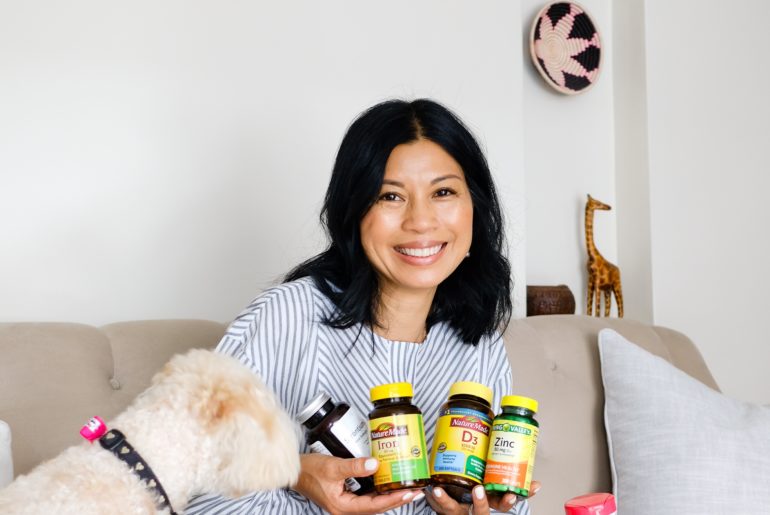Disclosure: This post is sponsored by Hologic. Although I have been compensated, all opinions are my own.


Did you know that preventive screening is our best tool in the fight against breast cancer, a disease that will affect 1 in 8 women in their lifetime? Preventive care is critical to our overall health and can significantly increase life expectancy.
Ever since I was diagnosed with fibrocystic breast disease in my early 20s, I took preventive care seriously. I’ve been diligent about getting my clinical breast exam annually since then.
I still remember when I was first diagnosed with the disease. After the examination, I was immediately referred to a Radiologist to have a mammogram to rule out breast cancer. Mammograms are x-rays of the breasts that screen for tumors or deposits of calcium that can form in the tissue. When cancer is detected early, it’s often more treatable.

The x-ray showed many lumps on my breasts – all 12 of them that could fill up a full-size cup. I was terrified and the first thought that came to my mind was that I may be at risk for breast cancer.
The NIH recommends screenings start for women around the age of 40, depending on risk and health history. Ever since that first visit, I adopted the “just do it” approach by requesting a mammogram screening every single year even though it was not required because my condition and family history was considered low risk.
I’m so glad I did.
A few years later and while going in for my routine mammogram screening a huge lump was discovered on one of my breasts. The image from the 2D mammogram machine was not accurate enough to determine the definition of the lump. The next day I went back in for a second mammogram for more images at different angles plus a breast MRI screening. The doctor was not 100% sure so it was recommended that a biopsy procedure should be done to completely rule out cancer. Luckily it was benign. That lump now has an X marked inside my breast to indicate that it had been biopsied.
I have to admit that getting a mammogram is not something I look forward to every year because it is very uncomfortable and at times, very painful. On my last visit, I had to go back for my second mammogram because the images from my first were blurry. But I know it is something that I must do for early detection of cancer.

You all know I am an advocate for living a healthy lifestyle physically and mentally because health maintenance is very important to me. I eat clean food whenever available and avoid all processed foods if possible. I don’t smoke and only drink socially. I practice yoga three times a week and do long walks with my family at least 4 times a week after supper. I try to get my 8-hours of sleep whenever I can. I see my dentist twice a year to keep my teeth and gums healthy. And most importantly, I visit my physician once a year to receive preventative services like mammograms to stay up to date – it is one of the most important things I can do to stay healthy.
I recently learned about Hologic’s Genius™ 3D Mammography™ exam, the only mammogram that detects more invasive cancers, reduces false positives, and is FDA approved as superior to conventional 2D mammography for all women, including those with dense breasts like me. (1,2,3)
The SmartCurve™ Breast Stabilization System, available exclusively with Hologic’s Genius Mammography exam, has been clinically proven to deliver a more comfortable mammogram without compromising image quality, workflow or dose.(4) The SmartCurve system features a proprietary curved surface that mirrors the shape of a woman’s breast to reduce pinching and allow better distribution of force over the entire breast during a mammogram. Basically, with this technology, our breasts are no longer pinched to have the images taken.
Now that I have learned so much about the SmartCurve system I will definitely inquire about the Genius 3D mammography exam on my next visit because this exam has better detection and, when used with the SmartCurve system, is more comfortable than the standard flat compression surfaces that I’ve been screening with.(1,4)
Even though Women’s Health month is over that doesn’t stop me from striving to become an advocate for my own health. And it shouldn’t stop you either. And although October is Breast Cancer Awareness month don’t wait until then to take care of your breast health. In the long run, it’s more cost effective to take steps to prevent disease than pay for treatments.
To find the nearest facility that offers this exam, visit www.Genius3DNearMe.com and enter your zip code.

The Genius™ 3D Mammography™ exam (also known as the Genius™ exam) is only available on a Hologic® 3D Mammography™ system. It consists of a 2D and 3D™ image set, where the 2D image can be either an acquired 2D image or a 2D image generated from the 3D™ image set. There are more than 6,000 Hologic 3D Mammography™ systems in use in the U.S. alone, so women have convenient access to the Genius exam. To learn more about the Genius exam, visit http://www.Genius3DNearMe.com.
1 Results from Friedewald, SM, et al. “Breast cancer screening using tomosynthesis in combination with digital mammography.” JAMA 311.24 (2014): 2499-2507; a multi-site (13), non-randomized, historical control study of 454,000 screening mammograms investigating the initial impact the introduction of the Hologic Selenia® Dimensions ® on screening outcomes. Individual results may vary. The study found an average 41% (95% CI: 20-65%) increase and that 1.2 (95% CI: 0.8-1.6) additional invasive breast cancers per 1000 screening exams were found in women receiving combined 2D FFDM and 3D™ mammograms acquired with the Hologic 3D Mammography™ system versus women receiving 2D FFDM mammograms only.
2 Bernardi D, Macaskill P, Pellegrini M, et. al. Breast cancer screening with tomosynthesis (3D mammography) with acquired or synthetic 2D mammography compared with 2D mammography alone (STORM-2): a population-based prospective study. Lancet Oncol. 2016 Aug;17(8):1105-13.
3 U.S. Food & Drug Administration Premarket Approval (PMA). FDA.gov https://www.accessdata.fda.gov/scripts/cdrh/cfdocs/cfpma/pma.cfm?id=P080003S005 accessed June 5, 2017.
4 Smith, A. Improving Patient Comfort in Mammography. Hologic WP-00019 Rev 003 (2017).




2 Comments
Thanks for the tips. That outfit is really cute! Thanks for posting!
Thank you so much for your support!